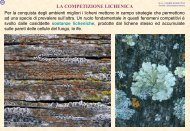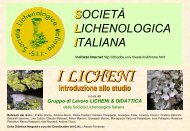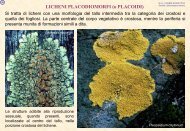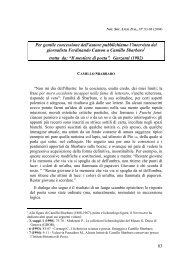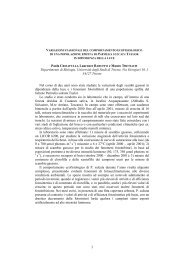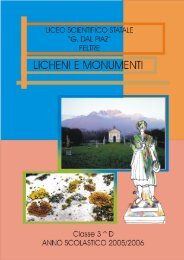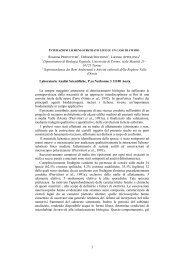KEY to terricolous lichens - italic
KEY to terricolous lichens - italic
KEY to terricolous lichens - italic
Create successful ePaper yourself
Turn your PDF publications into a flip-book with our unique Google optimized e-Paper software.
9<br />
Thallus foliose, homeomerous, dark olive green <strong>to</strong> brownish black, thick. Lobes 1-<br />
2(3) mm wide, elongate, convex, adpressed <strong>to</strong> the substratum, very variable in shape,<br />
from radiating <strong>to</strong> subterete and ascending, flattened or concave. Apothecia frequent,<br />
lecanorine, sessile, up <strong>to</strong> 3 mm diam. Surface brown <strong>to</strong> black. Margin distinct, thick,<br />
smooth. Ascospores many-celled, hyaline, ellipsoid, submuriform, 8 per ascus, 17-<br />
26(30) x 8.5-10.5(13) µ. Pho<strong>to</strong>biont cyanobacterial. Excipulum<br />
euthyplectenchyma<strong>to</strong>us. - Note: on more or less calciferous or base-rich soil (e.g. in<br />
dry grasslands), on consolidating sand and <strong>terricolous</strong> bryophytes, more rarely directly<br />
on rock, often in disturbed habitats such as track sides, also found in large urban<br />
settlements (e.g. in the very center of Rome), certainly the most common species of<br />
the genus in Italy.<br />
Ascospores per ascus 4 10<br />
10 Thallus thick. Lobes convex, ascending<br />
Collema ceraniscum<br />
Thallus foliose, homeomerous, black, thick, lobulate. Lobes 1-2(3) mm wide, convex,<br />
smooth, contiguous, ascending, subterete. Edge lobed. Undersurface black. Apothecia<br />
frequent, lecanorine, sessile, up <strong>to</strong> 1 mm diam. Surface brown <strong>to</strong> black. Margin<br />
distinct. Ascospores many-celled, hyaline, ovoid, cubical when young, submuriform,<br />
4 per ascus, 20-36 x 13-22 µ. Pho<strong>to</strong>biont cyanobacterial. Excipulum<br />
euthyplechtenchyma<strong>to</strong>us. – Note: over frost-disturbed ground on weakly calcareous<br />
substrata, a northern species, <strong>to</strong> be looked for throughout the Alps.<br />
10 Thallus thin. Lobes plane, subcrus<strong>to</strong>se, adpressed <strong>to</strong> the substratum<br />
Collema limosum<br />
Thallus foliose <strong>to</strong> subcrus<strong>to</strong>se, homeomerous, black, thin, continuous. Lobes flattened,<br />
contiguous, adpressed <strong>to</strong> the substratum. Apothecia frequent, lecanorine, sessile, up <strong>to</strong><br />
3 mm diam. Surface brown <strong>to</strong> black. Margin distinct, thick, verruculose. Ascospores<br />
many-celled, hyaline, ellipsoid, submuriform, 4 per ascus, 26-34 x 10-15 µ.<br />
Pho<strong>to</strong>biont cyanobacterial. Excipulum euthyplectenchyma<strong>to</strong>us. - Note: a short-lived<br />
species of mineral, clay soil in disturbed habitats, certainly overlooked, but never<br />
common in Italy.<br />
11 Pho<strong>to</strong>biont chlorococcoid 12<br />
11 Pho<strong>to</strong>biont cyanobacterial 23<br />
12 With soredia<br />
Parmelia sulcata<br />
Thallus foliose, grey, K+ yellow, C-. Lobes (2)3-6 mm wide, elongate, flattened,<br />
adpressed <strong>to</strong> the substratum, truncated. Edge angular. Pseudocyphellae linear, on<br />
upper surface. Soredia grey. Soralia linear, laminar. Rhizines dark, simple, abundant<br />
at margin. Medulla K+ yellow changing <strong>to</strong> red, C-, KC+ orange, P+ orange. Medulla<br />
UV -. Apothecia rare, lecanorine, sessile, strongly constricted. Surface brown. Margin<br />
distinct, grey. Ascospores 1-celled, hyaline, ellipsoid, 8 per ascus, 11-15 x 6-8 µ.<br />
Pho<strong>to</strong>biont chlorococcoid. - Note: certainly the most common and wide-ranging<br />
Parmelia in Italy, also present near large urban settlements in the north, rare only in<br />
the eu-Mediterranean belt.<br />
12 Without soredia 13<br />
13 Marginal cilia present<br />
Anaptychia ciliaris<br />
Thallus foliose, grey <strong>to</strong> grey-brown, bifacial, shrubby, loosely attached, with thin<br />
transparent hairs, K-, C-, P-. Lobes (2)3-6 mm wide, linear, ascending. Edge entire,<br />
with marginal cilia. Undersurface pale brownish <strong>to</strong> white, channelled. Lower cortex<br />
absent. Apothecia frequent, lecanorine, substipitate, strongly constricted, up <strong>to</strong> 5 mm<br />
diam. Surface black, often faintly pruinose. Margin distinct, verrucose, grey <strong>to</strong> grey<br />
brown, smooth or crenulate. Ascospores 2-celled, not hyaline, ellipsoid, constricted at<br />
septa, thin-walled, ornamented, 8 per ascus, 40-45 x 18-24 µ. Pycnidia semiimmersed.<br />
Conidia bacilliform. Pho<strong>to</strong>biont chlorococcoid. - Note: on bark of<br />
deciduous, rarely coniferous, more or less isolated trees, sometimes also on rock and<br />
amongst <strong>terricolous</strong> mosses in open situations, locally common in the Apennines and<br />
in the islands.<br />
13 Marginal cilia absent 14<br />
10



